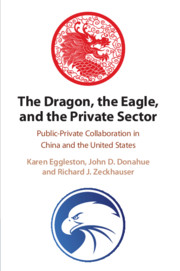 The Dragon, the Eagle, and the Private Sector
The Dragon, the Eagle, and the Private Sector from Part I - The Framework
Published online by Cambridge University Press: 05 February 2021
Collaborative governance (CG) can outperform other ways to pursue public goals in important circumstances. The conceptual framework developed in this chapter identifies those circumstances and defines the principles and design features required for success. The chapter then examines some salient elements of the Chinese and US context that shape adoption of the collaborative approach in each country.
Five straightforward diagnostic questions define where and how CG should operate. First, should some missions involve government at all, rather than being left to private parties? If the answer is “no,” then we’re done – at least for the purposes of this book. Second, if the answer is “yes,” should the government produce the service itself, or should it delegate production (in whole or in part) to the private sector? Third, for functions that should be delegated, how should that delegation take place?
To save this book to your Kindle, first ensure no-reply@cambridge.org is added to your Approved Personal Document E-mail List under your Personal Document Settings on the Manage Your Content and Devices page of your Amazon account. Then enter the ‘name’ part of your Kindle email address below. Find out more about saving to your Kindle.
Note you can select to save to either the @free.kindle.com or @kindle.com variations. ‘@free.kindle.com’ emails are free but can only be saved to your device when it is connected to wi-fi. ‘@kindle.com’ emails can be delivered even when you are not connected to wi-fi, but note that service fees apply.
Find out more about the Kindle Personal Document Service.
To save content items to your account, please confirm that you agree to abide by our usage policies. If this is the first time you use this feature, you will be asked to authorise Cambridge Core to connect with your account. Find out more about saving content to Dropbox.
To save content items to your account, please confirm that you agree to abide by our usage policies. If this is the first time you use this feature, you will be asked to authorise Cambridge Core to connect with your account. Find out more about saving content to Google Drive.